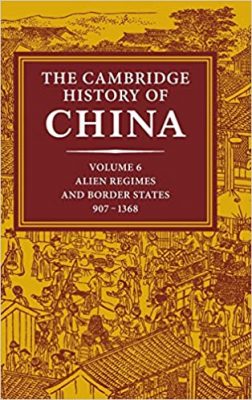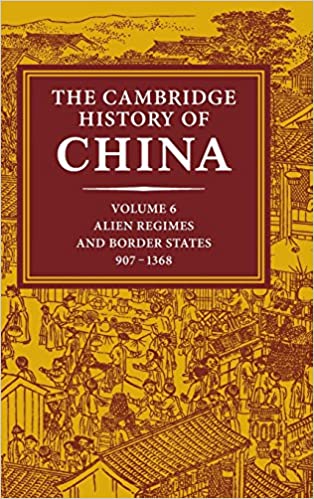 Editors: Herbert Franke and Denis Twitchett
Editors: Herbert Franke and Denis Twitchett
General Editors: Denis Twitchett and John K. Fairbank
Publisher: Cambridge University Press – 864 pages
Book Review by: Sonu Chandiram
The regimes that form the essential content of this volume are considered as ‘alien’ by Chinese historians, and have received negative treatment in general. These regimes were established by a non-Chinese ruling group that challenged the then existing hegemony.
These foreign rulers maintained their own cultural identities while ruling over large Chinese territories and populations. The editors write in the Introduction: “Each regime presented a challenge to the integrity of Chinese culture, and to China’s deeply rooted assumptions about its cultural supremacy and international order.”
But the editors Herbert Franke and Denis Twitchett contend that these foreign regimes were ‘highly successful’. Why? For these reasons (in their own words):
- The Khitan Liao dynasty lasted longer than had any previous Chinese dynasty except for the Han and the T’ang
- For more than a century after the fall of the T’ang dynasty in 907, the Tangut in northern Shensi and Kansu clung tenaciously to the regional authority that they had acquired under the late T’ang and then formed their own empire of Hsia, which as an independent state had survived for two centuries more.
- More than two centuries after the collapse of Khitan power, the official historian of the Mongol Yuan court grudgingly conceded to the Liao the title of a legitimate dynasty but denied that status to the Hsia, who would seem to us to have almost as good a claim.
- Both were long-lasting, stable regimes, firmly rooted in territories that had been in part settled by Han Chinese for a millennium, and both regimes survived in the face of a hostile Chinese regime, the Sung, whose population outnumbered them twenty to one, and whose economic resources were even more overpoweringly superior.
- Both fought the Sung to a standstill, forced the Sung to recognize their existence and parity as sovereign regimes, and extracted large subsidies from them in exchange for peace.
This book contains a lot of supporting material to enhance your understanding of the period covered in this volume. The materials include:
- Thirty-seven maps that illustrate locations and extents of the regimes during particular ranges of years; invasions, growths, populations distributions and movements; declines and falls of various regimes; and campaigns, conquests, and destructions.
- Eight tables that show the numbers of households in various locations, populations in cities, as well as details such the titles of the various rulers within China.
- Six figures that depict genealogies of the emperors, ruling houses, and rulers
To provide you a broad overview of what you will find within the over 860 pages that constitute this book, we provide for you the titles of its nine chapters below.
Introduction
- The Liao
- The Hsi Hsia
- The Chin Dynasty
- The Rise of the Mongolian Empire and Mongolian Rule in North China
- The Reign of Kublai Khan
- Mid-Yuan Politics
- Shun-ti and the End of Yuan Rule in China
- The Yuan Government and Society
- Chinese Society Under Mongol Rule, 1215-1368
This book provides extensive coverage of a period of China’s history spanning nearly five centuries. It reflects detailed research, scholarship and hard work conducted by Herbert Franke and Denis Twitchett to make this excellent volume a reality. We heartily congratulate them for this laudable, highly useful accomplishment – a valuable contribution to our understanding of Chinese history.
Editors:
Herbert Franke (27 September 1914 – 10 June 2011[1]) was a German historian of China. He is particularly known for his works on the history of the Jurchen (Jin) and Mongol (Yuan) Empires in China.
After the end of World War II, Herbert Franke, along with Wolfgang Bauer, was instrumental in establishing the Sinological Section in the University of Munich. Later, he succeeded Erich Haenisch as the head of the Sinology Department at that university.
He is one of the authors of volume 6 of The Cambridge History of China dealing with history of China under the Khitan, Jurchen and Mongol regimes. (Source: Wikipedia)
Denis Twitchett was born on 23 September 1925 in London, England, the son of an architectural draughtsman, and attended Isleworth County Grammar School. During World War II he took a crash course in Japanese, and for the remainder of the war he was part of the Bletchley Park operations acting as a listener at one of the forward listening stations in Sri Lanka.
He also spent a great deal of time in Japan, and was able to learn from the best Japanese historians of China (who tended to focus on Tang China, a period which became his field of expertise also). Following demobilisation he read Modern Chinese at the School of Oriental and African Studies at the University of London for a year (1946-47).
Having won a scholarship to read Geography in 1943 while still a school pupil, he then took up his place at St Catharine’s College, Cambridge, whence he graduated with a first-class degree in Oriental Studies in 1950.
He was a lecturer at the University of London (1954–56) and Cambridge (1956–60), the Chair of Chinese at the universities of London (1960–68) and Cambridge (1968–80), and the Gordon Wu ’58 Professor of Chinese Studies at Princeton University (1980–94). He was a fellow of the British Academy from 1967. He greatly expanded the role of Chinese studies in Western intellectual circles. He married Umeko Ichikawa in 1956. Together they had two children. (Source: Wikipedia)







